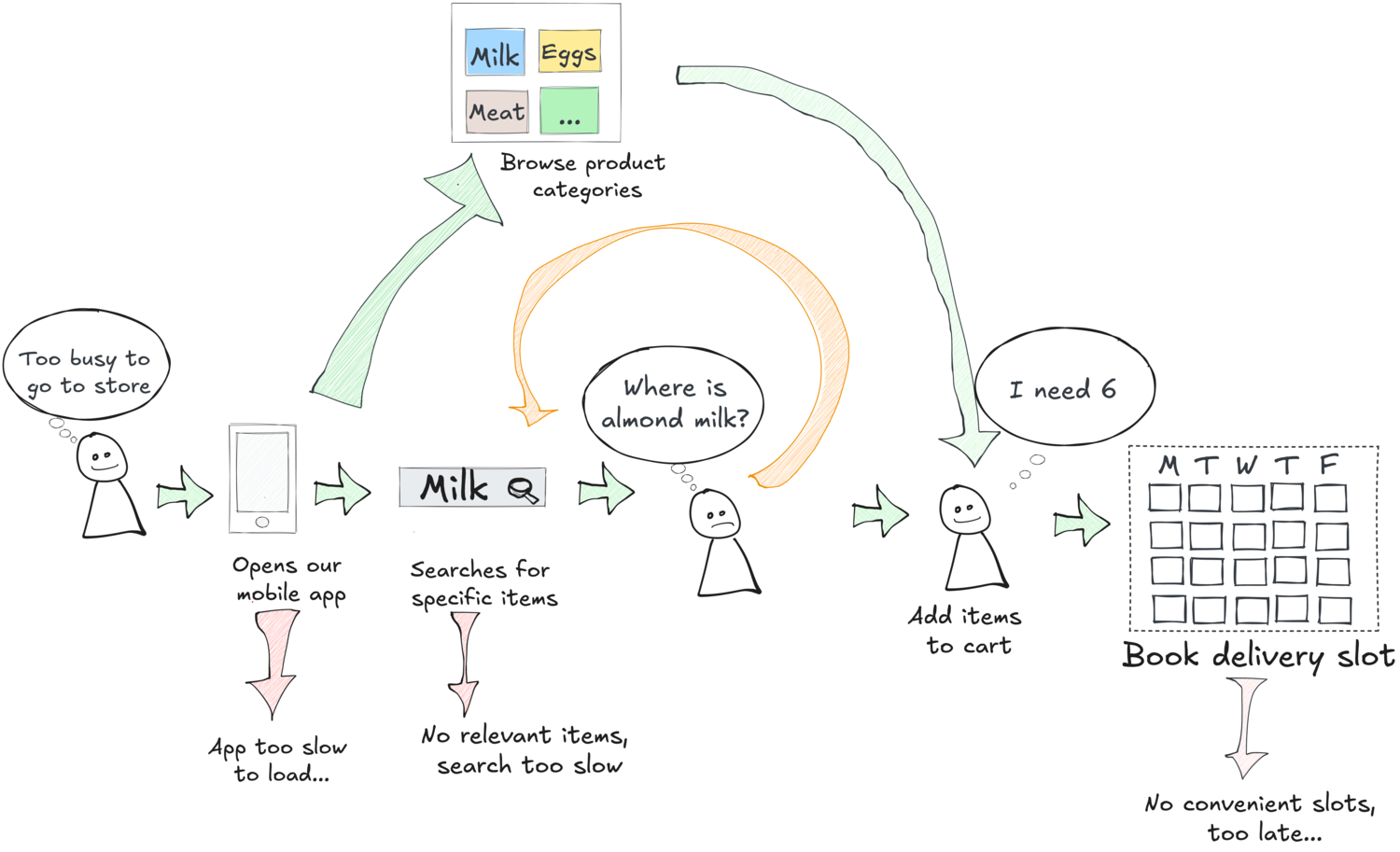Experience Mapping
Experience Mapping is a technique for visualising customer issues and building a shared understanding about potential product opportunities. It can be useful as a first step in deciding about potential impact or outcomes to explore for further product research or planning. In particular, it’s common to run an experience mapping session before creating an Opportunity Solution Tree, but this method can also be used with other road-mapping or prioritisation techniques.
Experience Mapping was introduced by Teresa Torres, in her 2021 book Continuous Discovery Habits.
What does an Experience Map look like?
An Experience Map shows an assumed workflow some specific persona or group of customers experiences when using a product, in particular focusing on the known challenges people face. Visually, it is a directed graph, containing nodes and links. A node is a user action or an event, representing a distinct moment in time. Links show relationships and transition between nodes. Additional context, capturing what users think, feel or do at each step of the journey can be shown with visual elements connected to nodes (such as speech bubbles).
The map should capture where users get stuck, what went wrong, how people tried to work around the issues and where in the flow they abandon the process. It should not show just the happy path, but a journey also capturing how users commonly redo steps, give up due to frustration or go back in loops.

(open the image in a new tab)
When creating a map, use simple line graphics and avoid wasting time on getting the visuals right. Boxes, lines, smiley faces and stick figures are more than adequate for the purpose.
An experience map is not the target workflow for some ideal user segment, but the current state mapped out to the best of the knowledge of the people involved in making the product.
How to create an Experience Map?
In Continuous Discovery Habits, Torres suggests that experience mapping should be conducted by product managers, designers and engineers working on the product.
Clearly set out the scope for the experience map at the start of the mapping session. This includes selecting a specific persona or customer segment, the desired outcome, and a specific part of their journey with the product. Ask yourself “What’s preventing our customers from completing this workflow today?” This will prevent the group from being overwhelmed with options.
Start mapping individually, “to avoid groupthink”. Torres suggests that each participant in the mapping session should first draw the map from their knowledge and experience, then later try to develop a shared perspective. Creating individual maps will force everyone to participate, but also help to spot differences in understanding and identify gaps in people’s experience.
Draw the maps using pictures, avoid using words. Torres suggests that explaining a customer experience with words tends to lead to generalizations, but pictures help to show the context.
When we draw an experience map, rather than verbalize it, it’s easier to see gaps in our thinking, to catch what’s missing, and to correct what’s not quite right.
Teressa Tores, Continuous Discovery Habits
Once everyone creates an individual map, people should take turns to present their work to the rest of the group and share their point of view. The rest of the group should try to understand the presenter’s perspective, particularly paying attention to the differences with the other maps, and then ask questions to clarify and discuss the individual perspectives.
Finally, the team can build a common map to capture the shared perspective. Torres suggests creating a new map rather than modifying one of the existing ones.
- Create a new map combining all the nodes from individual maps
- Join similar nodes and eliminate duplicates
- Decide on the links between nodes, remembering to map out a realistic flow showing issues and not just a happy path
- Add the context about user feelings, thoughts and actions.
To avoid wasting time on long debates, Torres suggests visualising the differences instead of debating them.
Using an Experience Map
The Experience Map documents shared understanding about customer issues and provides a rich foundation for discovering customer problems and product opportunities. Importantly, it captures the current understanding of the people working on the product, and may not fully reflect reality. Product teams should test their understanding of customer issues through interviews with real users or potential customers, and revisit and update the map as they start to explore solutions. It’s important to update the experience map in a group, rather than individually, to ensure that people still share the same common perspective and maintain a shared understanding of customer issues.
Learn more about the Experience Mapping
- Continuous Discovery Habits: Discover Products that Create Customer Value and Business Value, ISBN 978-1736633304, by Teresa Torres (2021)